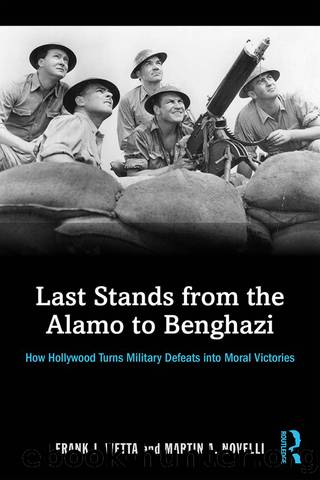Last Stands from the Alamo to Benghazi by Frank Wetta Martin Novelli

Author:Frank Wetta, Martin Novelli [Frank Wetta, Martin Novelli]
Language: eng
Format: epub
Tags: History, United States, General, Military, Wars & Conflicts (Other), 20th Century
ISBN: 9781317591924
Google: EHKuDQAAQBAJ
Publisher: Routledge
Published: 2016-12-08T16:19:53+00:00
Rogers was not exaggerating. In truth, frontier warfare was exceptionally vicious (on both sides). Here historian John F. Ross describes an Indian raid in New Hampshire in 1749 and Rogersâ retaliation:
The raiding party fired six houses and a barn, killed twenty-three cattle, one more item in a growing tally of dozens of homes and hard-won crop fields immolated along the frontier. The Indians tore out the fat-rich tongues of the livestock they slaughtered to devour on the trail. Dozens of colonists were scalped or borne off to uncertain fates in New France . . . By playing the enemyâs own game of waging fast, surprising, and destructive small-unit warfare, Rogers was gambling that he could take the teeth out of the Indiansâ will to continue their alliance with the French. It was a bold gamble.3
The movie follows Rogersâ own account of the attack accurately: âAt half an hour before sunrise I surprised the town when they were fast asleep, on the right, left, and center, which was done with clarity by both officers and men, that the enemy had not time to recover themselves, or take arms for their own defense, till they were chiefly destroyed, except some few of them who took to the water. About forty of my men pursued them, destroyed such as attempted to escape that way, and sunk them and their boats.â Rogers claimed to have killed 200 Indians (and the screenplay repeated the claim). But the number may have been much lowerâ30 in all, including 22 women and children. The third act of the film recounts the disastrous retreat as the French and Indians chase the raiders through the forest. Exhausted, pressured by the enemy, and running out of food the raiders break up into four separate bands. It is all misery and starvationâsome even resorted to cannibalism. Others were killed, captured, and tortured, or went missing. One can see in the film how the racist views towards Native Americans would, once the U.S. entered the World War II, become the view of the Japaneseâa vicious and savage enemy. But the film was reasonably reflective of the history.
In the film, Rogers is pictured as an uncomplicated adventurerâa representative of Americaâs Manifest Destiny, an interpretation in tune with wartime propaganda. In truth, he was a very complicated personâmore mercenary than patriot. Ironically, despite Rogersâ decidedly mixed military reputation, today âMost of the veteran Rangers speak fondly of the 1940 MGM film Northwest Passage. â Perhaps, historian John F. Ross states, âIt may at first be hard to understand how the tradecraft of the modern-day special operator, parachuting into the Hindu Kush after the Taliban, or a lighting strike force pushing into the dangerous Pakistani borderland, could echo the efforts of men from the preindustrial community struggling through New England winters.â4 Nevertheless, âRogersâ Rules of Rangingââ28 guidelinesâstill apply for special operations in the age of asymmetrical warfare: the victory just over the ever receding horizon of American destiny. The attack on St. Francis was no significant military achievement and the aftermath was a disaster for the Rangers.
Download
This site does not store any files on its server. We only index and link to content provided by other sites. Please contact the content providers to delete copyright contents if any and email us, we'll remove relevant links or contents immediately.
It's Only a Movie! by Haberski Jr. Raymond J(182)
The Garden in the Machine by Unknown(155)
Euro-Visions: Europe in Contemporary Cinema by Mariana Liz(150)
The Greatest Show on Earth by Jerry Pinto(148)
Jafar Panahi: Interviews by Unknown(138)
Film and the Nuclear Age by Toni A. Perrine(129)
The Fellowship of the Knits: Lord of the Rings: The Unofficial Knitting Book by Tanis Gray(123)
RKO Radio Pictures Horror, Science Fiction and Fantasy Films, 1929-1956 by Michael R. Pitts(108)
THE GOLDEN AGE OF EROTIC CINEMA: 1959-1972 by Wiilliam Rotsler(108)
Horror Film by Murray Leeder(106)
Offbeat (Revised & Updated) by Julian Upton;(92)
The Last Interview by Nora Ephron(89)
Chinese films in focus II by Unknown(87)
Tuitions and Intuitions by William Rothman;(85)
Red, Blue, and Bronze: Inside the Symbols of the Wonder Woman Film by Frankel Valerie Estelle(82)
June Allyson: Her Life and Career by Peter Shelley(82)
Last Stands from the Alamo to Benghazi by Frank Wetta Martin Novelli(79)
Horror Films FAQ: All That's Left to Know About Slashers, Vampires, Zombies, Aliens, and More by John Kenneth Muir(78)
The Essential Humphrey Bogart by Constantine Santas(78)
